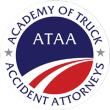Most automobile drivers are relatively unaware of some of the issues involved when encountering 18 wheelers and commercial trucks. Car drivers should consider the following tips to ensure the risk of having an accident with an 18 wheeler is minimized.
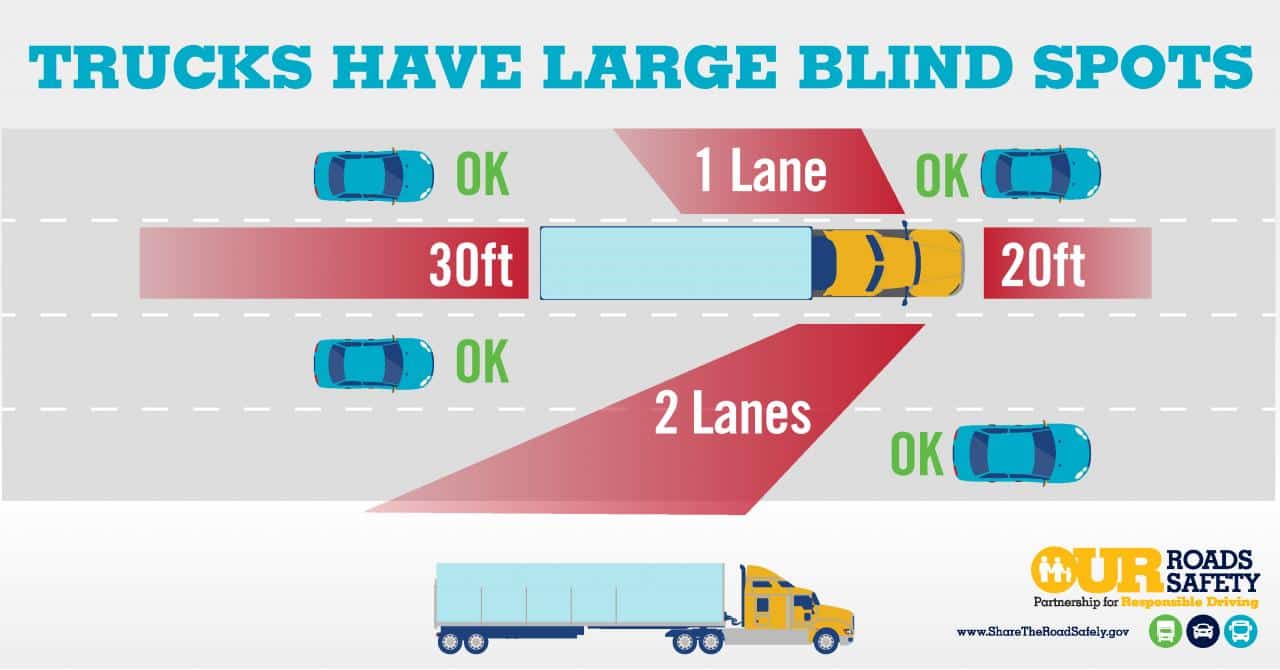
Here a truck’s blind spots, or “no-zones”:
- Left side, under the cab mirror;
- Right side, under the cab mirror and extending out;
- In front of the truck cab, at least 20 feet; and
- Behind the trailer, at least 30 feet.
Remember, if you can’t see a semi truck’s mirrors, the truck driver can’t see you.
While it’s true that it is the truck driver’s responsibility to change lanes safely, and to check for other vehicles, we all have a responsibility to drive safely and avoid crashes whenever possible.
A Solution to Dangerous Blind Spots?
Motor vehicle safety technology has advanced drastically in the last decades. It’s easy to forget that there’s been no real solution to this very real problem.
The closest thing to a solution thus far is “side-view assist.” Some of the more safety-conscious motor carriers have added this collision avoidance technology to their fleets.
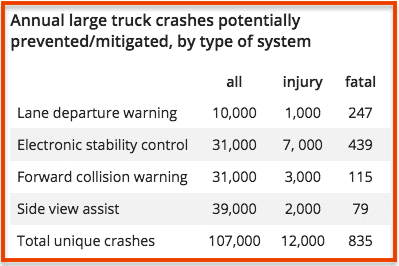
Back in 2010, IIHS found that side-view assist could affect up to 39,000 crashes each year.
That includes 2,000 serious to moderate injury crashes and another 79 fatal crashes.
Side view assist could remove blind spots for truck drivers, preventing up to 39,000 large truck crashes per year
Since this data was revealed in 2010, not much has changed.
There’s been no real advancement in applying blind spot technology in commercial trucks … but other autonomous features in trucks are progressing rapidly.
In the meantime, know the blind spots.
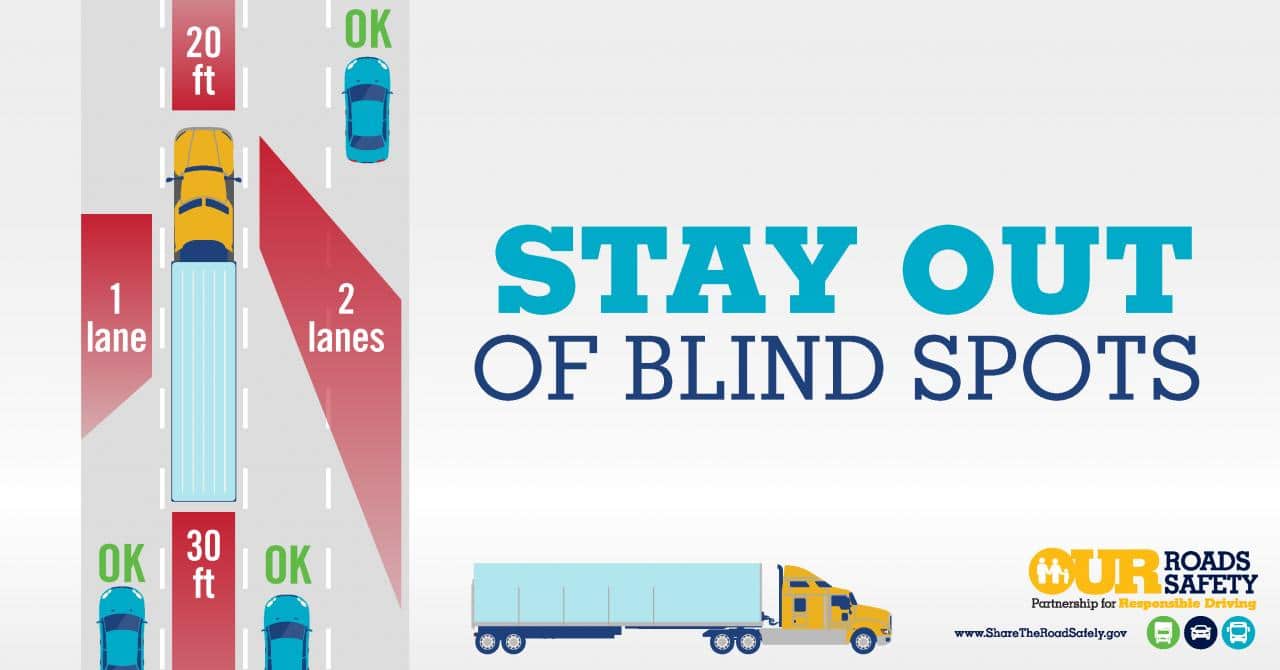
Many Texas drivers understand the fact that the size and weight of large commercial trucks add to the impact and the amount of damage a truck can do in a collision with a passenger vehicle. The truck weight of a loaded 18-wheeler or similar “big rig” means that a semi-truck driver needs a much greater distance to come to a stop to avoid a truck accident.
The Federal Motor Carrier Safety Administration (FMCSA), the agency that regulates interstate trucking, considers long stopping distances to be one of the top three safety challenges for large trucks and buses.
The FMCSA says a fully loaded truck traveling under good conditions at highway speeds requires a distance of nearly 200 yards—almost two football fields— to stop. That’s much more than the distance required of smaller passenger vehicles.
When a tractor-trailer follows too closely or is speeding, it’s easy to see the potential danger the large truck poses.
Truck Stopping Distance vs. Car Stopping Distance
To avoid accidents, commercial trucks and tractor-trailers need greater distance and time to come to a complete stop. Truck drivers have to be aware of this, especially if driving at high speeds.
Under ideal conditions, the FMCSA calculates the stopping distance of semi-trucks vs. cars as follows:
- A normal passenger vehicle traveling at a speed of 65 miles per hour would take about 300 feet to stop.
- For a fully-loaded commercial truck, the stopping distance of it running at 65 miles per hour is about 525 feet.
A truck’s stopping distance increases, even more, when it is hauling a heavy load and/or there are adverse road conditions like snow, ice or rain.
Trucks typically weigh 20 to 30 times more than passenger vehicles, with a truck weighing up to 40 tons (80,000 pounds) and a typical passenger vehicle at 2 tons (4,000 pounds). This affects a truck’s acceleration, handling and braking. A truck’s weight also makes it accelerate more quickly going downhill.
How Large Truck Brake Systems are Different?
There are basically three elements to “total stopping distance”:
- Perception Distance – The distance a vehicle travels as the driver identifies the need to slow down or stop to avoid a hazard.
- Reaction Time – The time it takes for the driver to act upon the decision to slow down once he or she has recognized the need.
- Braking Distance – The distance a vehicle travels from the time a semi-truck driver begins pressing on the brake pedal until the vehicle comes to a stop.
A fourth factor that applies to trucks is “brake lag.” Brakes on semi-trucks are not like brakes on regular passenger vehicles. Most passenger vehicles on the road have hydraulic brakes, which are liquid and faster. Semi-trucks have air brakes, which have a lag time.
You’ve probably heard the whooshing sound of air escaping a large truck’s brake system as it came to a stop beside you at a light. When a trucker first applies brakes, the air has to build up and spread the length and breadth of the truck before the brakes can actually begin to slow the vehicle. This adds to stopping time and distance.
A truck’s “service brakes” are used during normal driving.
A sequence of events occurs when a trucker pushes the brake pedal:
- Air moves into a brake chamber through airlines.
- The air forces out a pushrod.
- The pushrod pushes the slack adjuster.
- The camshaft turns.
- The turning of the camshaft twists the S-Cam.
- The brake linings are forced to contact the brake drum.
If the brake drum overheats, it will expand away from the brake shoes. Then the drum and shoes won’t make complete contact. The other brakes must work harder to compensate. If the situation continues too long, other parts of the system will also overheat and fade, leading to brake failure.
In 2009, the National Highway Traffic Safety Administration (NHTSA) issued long-awaited new braking standards requiring a tractor-trailer traveling at 60 miles per hour to come to a complete stop in 250 feet, versus the old standard of 355 feet – a reduction of truck stopping distance of roughly 30 percent.
Under the rule, a small number of very heavy tractor-trailers are required to stop at 310 feet when running at 60 mph. In addition, the rule requires that all heavy fully loaded tractor-trailers stop within 235 feet when loaded to their lightly loaded vehicle weight.
When the NHTSA adopted the rule, it estimated that the new braking requirement would save 227 lives and prevent 300 serious injuries annually, while reducing property damage costs by over $169 million a year.
In 2015, NHTSA began the years-long process of rulemaking to require forward collision warning and automatic braking capability on trucks with a gross vehicle weight rating of 10,000 pounds or more. While this technology is significantly reducing rear-end crashes in passenger vehicles in the U.S., most commercial trucks sold here don’t have front-crash prevention.
How to Avoid a Truck Accident
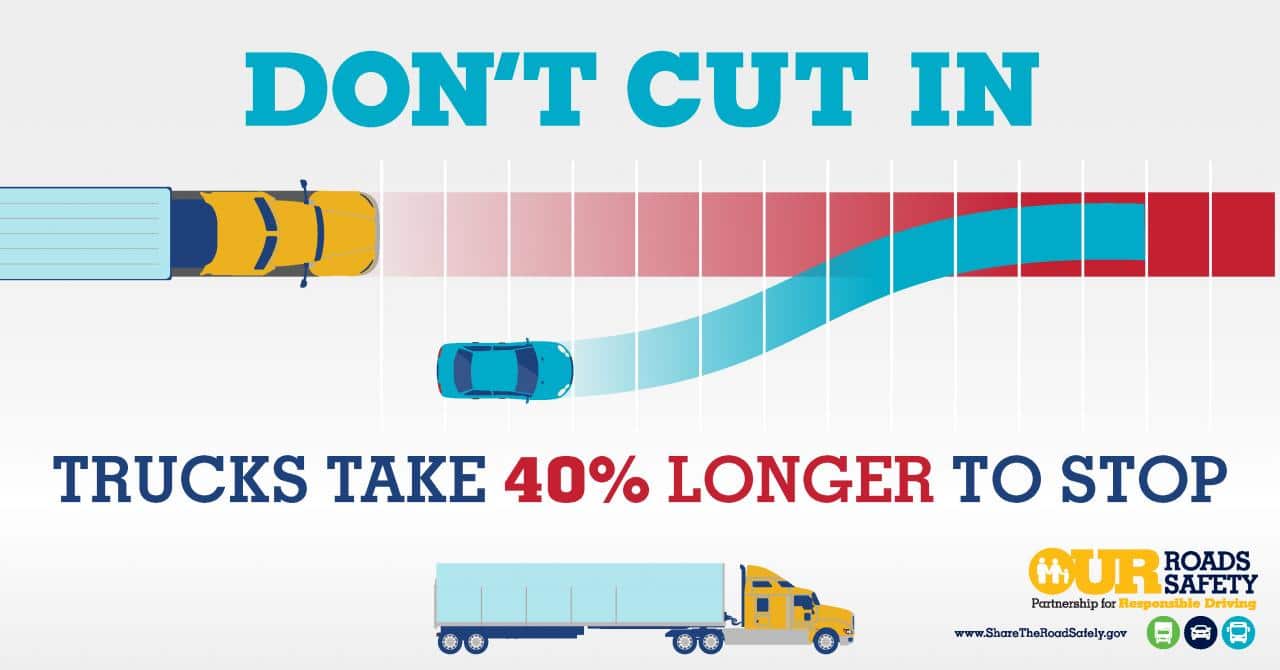
A Texas defensive driving instructor suggests using caution when driving near large trucks and staying away from fast-moving trucks on open roadways when possible.
You should give a truck extra space and stopping distance whenever possible, and you should always leave an escape option on the road.
Other tips for avoiding a collision with a large truck include:
- Don’t cut in front of large trucks, because they take longer to come to a complete stop.
- Allow a safety cushion. Keep a safe following distance between you and a truck ahead of you. Look a quarter-mile down the road and keep up with upcoming exits. Truckers often cause accidents by making unexpected lane changes to exit the highway.
- Stay out of blind spots. If you can’t see the truck driver in his or her side mirrors, then the truck driver cannot see you and could make a lane change into your vehicle.
- Use caution when driving near tractor-trailers.
Is the Truck Driver to Blame for Brake Failure That Led to an Accident?
Even when automated braking and collision warning systems become a requirement for America’s long-haul trucking fleets, truck drivers will still be responsible for operating their vehicles safely on public roads to avoid accidents.
Trucking companies will continue to be responsible for ensuring brakes are maintained and operating properly when their vehicles are on the road.
When truckers or truck owners act negligently and cause truck crashes, innocent drivers or others who have been injured have a right to seek compensation for their losses.
If you have been injured in a truck accident in Texas, you should discuss your legal options to pursue an injury claim with a knowledgeable truck accident attorney. At McKay Law, our attorneys represent people injured in truck crashes and handle cases on a contingency-fee-basis. We only get paid if we obtain an insurance settlement or jury award for our client. Contact us now in East Texas for a free discussion of your case.
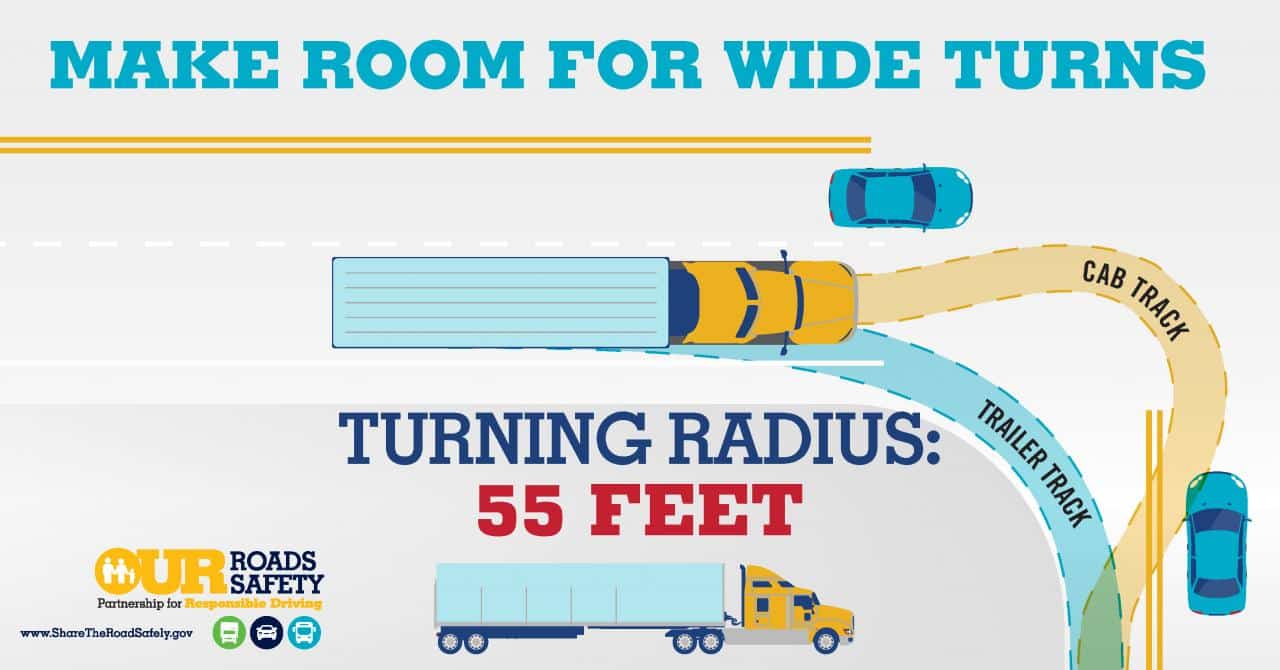
Why Are Wide Turns So Dangerous for Trucks?
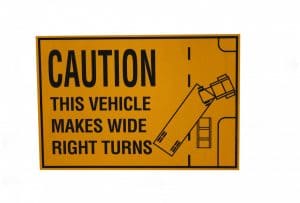
In Texas, there is no shortage of commercial motor vehicles on the road. Tractor trailers are often driving alongside us, whether they are delivering product nearby or simply passing through. Truck drivers face many unique challenges compared to those who drive standard-sized vehicles and this, unfortunately, means human error is both more common and deadlier. Wide turns specifically are as dangerous as they are unavoidable, and while this may not be news, ensuring you truly understand why and how may help you avoid a tragedy in your future.
The role of height in a truck accident
The root of almost all difficulties pertaining to driving a truck is the size of it in comparison to other cars on the road. As trucks are so commonplace, it is easy to become desensitized towards the sheer mass and volume of a typical 18-wheeler, and this means one may make the mistake of treating said 18-wheeler like a sedan. This can be a life-threatening error.
For example, due to the height of a truck, there is a much higher center of gravity. This means it is far easier for a truck to overturn and roll over. Aside from the obvious danger of being in the direct path of such an accident, it is also important to consider the materials the truck may be transporting. Commercial vehicles often have hazardous – and sometimes explosive – materials on board that can cause damage to other cars and those within them, even if they avoid an actual collision. Flammable or noxious substances are always present regardless of what is being transported, which means even an empty truck overturning can become a fire.
Even without them, any cargo deposited on busy roads, especially in sudden fashion, can cause other accidents across several lanes and usually shut highways down entirely for a time. In just October, a truck overturned and caught on fire, spilling 84,000 pounds of steel across I-65 in Nashville. Luckily, even the driver of the truck escaped without injury, but all lanes except one were shut down for several hours due to the extensive clean-up required.
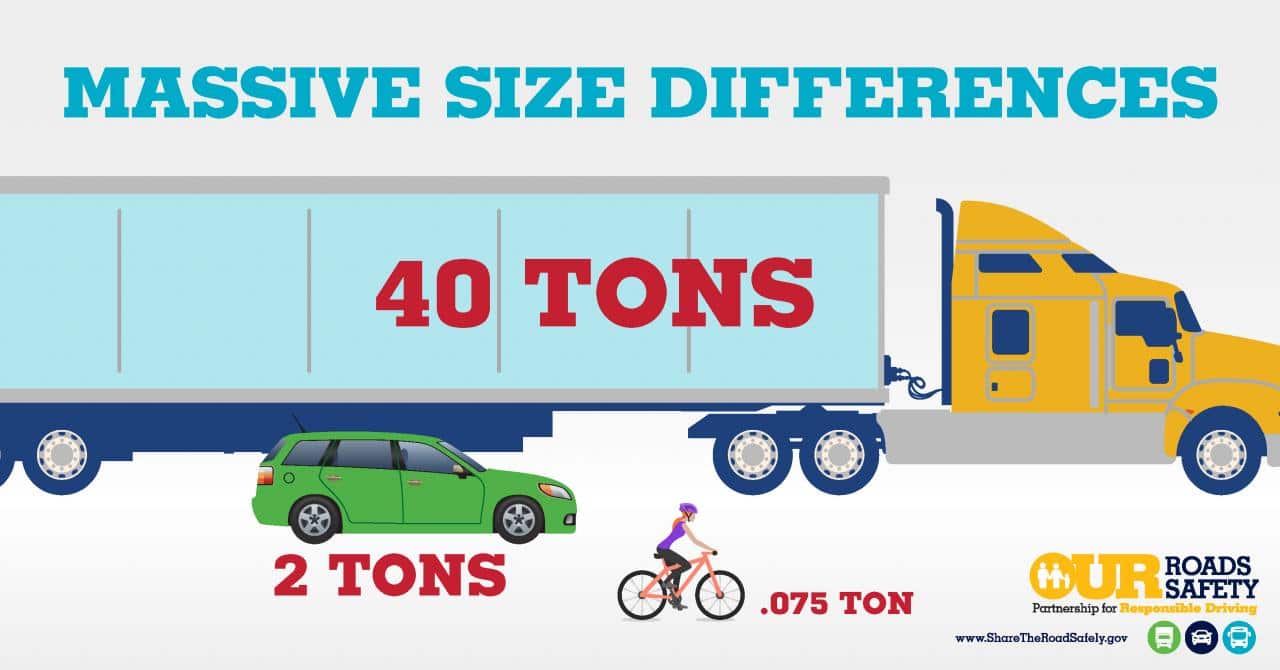
Another complication born of height is the number of blind spots trucks have. Any part of a truck where the sideview mirrors are not visible is a blind spot. A negligent truck driver may not check these blind spots properly when changing lanes or turning and this can catch other drivers off-guard. Smaller vehicles in the next lane on either side need to be vigilant and should work on exiting the truck’s blind spot as quickly as possible.
Due to the extreme, all-around mass of trucks, they are not able to maneuver as easily or tightly as other vehicles. You may notice a truck with a sticker warning other drivers not to pass them on the right. This is because a typical truck has a 55 foot turning radius that requires them to veer left before turning right, creating a multi-lane but tight maneuver that may trap and injure other vehicles. Without wide turns, the height and weight of a truck would easily send it off-road and overturned due to lack of space. With them, however, and thanks to the onboard materials, flammability, and mass of trucks, it can lead to catastrophe.
Dangerous Human Error
Truck accidents are no rare occurrence, and often this is due to human error from the driver. Controlling a vehicle as large as a truck, as previously explored, comes with a host of dangers and challenges typical car drivers simply do not need to take as seriously. This puts the onus on the driver to be hyper-vigilant of all regulations and laws and hyper-aware of everyone else they are sharing the road with. Unfortunately, negligent driving is an epidemic amongst truckers. Fatigue, intoxication, unsafe lane changes, and speeding are dangerous to every driver of any vehicle, but the size of trucks means the consequences of these behaviors is far more likely to be dire.
Speeding trucks, for example, are especially dangerous due to the extra time required to properly slow down or stop. It takes longer to brake as a truck, and with their limited maneuverability, they may not be able to react quickly enough to avoid a collision or crash. They are also at higher risk of losing control and overturning the truck if a wide turn is taken too quickly due to simple momentum and physics.
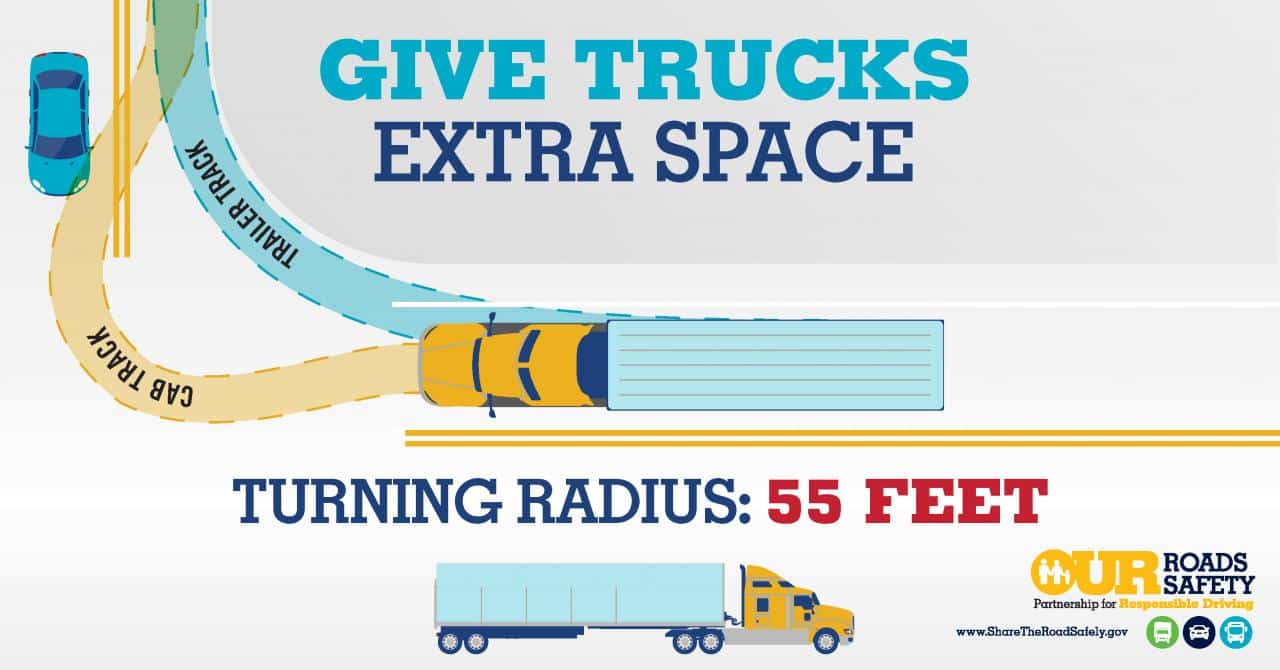
Fatigued and intoxicated drivers have impaired judgment and motor skills, which can lead to them making errors such as unsafe lane changes (lack of blind spot checks) and speeding. The long hours required of truckers, especially if they skip their legally required breaks from the road, means fatigue is the most common cause of these deadly mistakes.
Although it may not be possible to entirely avoid the trucks who share the road with us, their negligent drivers can still be held accountable. Companies with commercial trucks may try to shirk responsibility and seek loopholes to certain regulations, but with a skilled Texas truck accident attorney at your side they will not get away with it. If you or a loved one were involved in a truck accident, McKay Law attorneys are ready to assist you in East Texas. Call us today at (903) 999-2653 or submit your case for a free consultation to gain legal protection you can trust.
Always give 18 wheelers and commercial trucks extra space so you do not get hit. Give plenty of space.

Work Zone Accidents frequently involve large trucks or commercial vehicles.
Be on the lookout and give plenty of space to large vehicles when you encounter a work zone. Stay alert.
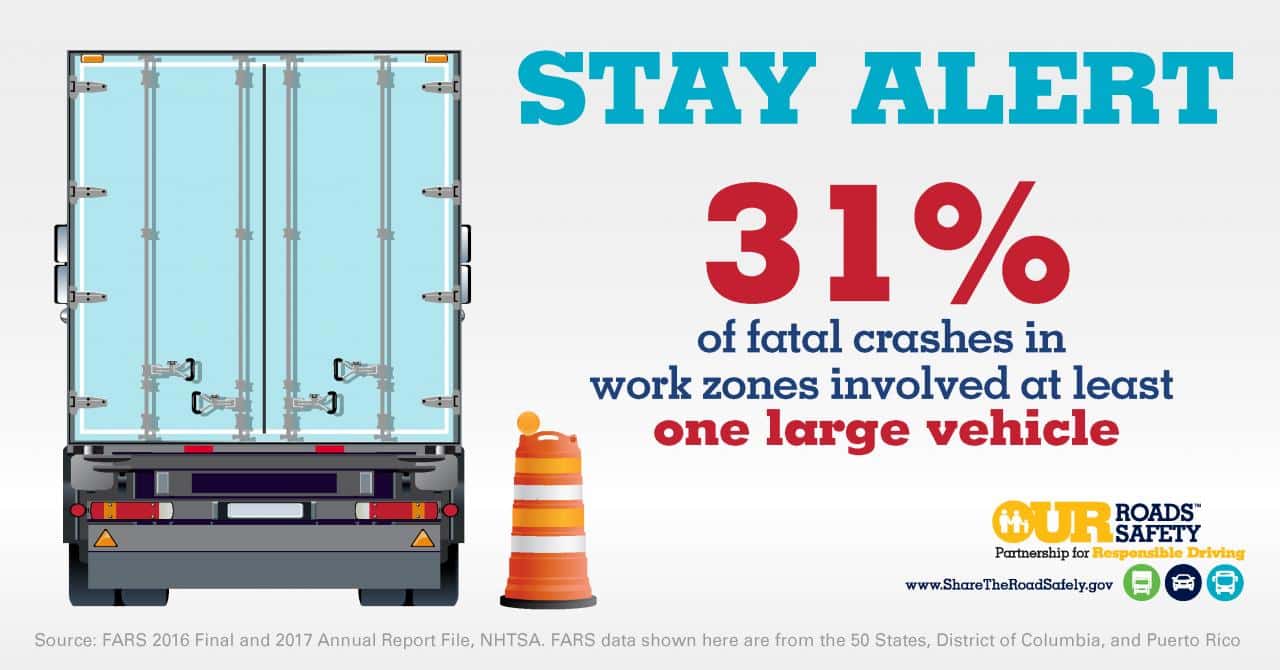
TxDOT reminds motorists to make driving safely a priority when passing through the state’s more than 3,400 active work zones. In 2020, more than 22,000 traffic crashes occurred in work zones in Texas, resulting in 186 deaths, a 9 percent increase in traffic fatalities over the previous year. Another 680 people were seriously injured.
Drivers and their passengers account for the majority of those involved in fatal work zone crashes. In 2020, 147 motorists and vehicle passengers were killed in Texas work zones. Four construction workers and 35 pedestrians and bicyclists were also killed. The leading causes of work zone crashes– speeding, driver inattention, and unsafe lane changes – are entirely preventable.
Driver Safety
Work zones present a different and sometimes challenging environment for drivers to navigate. Drivers may encounter uneven pavement, narrow lanes, concrete barriers, slow-moving heavy equipment and vehicles that make sudden stops. Please keep the following tips in mind when driving through work zones:
- Slow down, follow the posted work zone speed limit and drive to conditions. Traffic fines double in work zones when workers are present and can cost up to $2,000.
- Pay attention. Avoid distractions, keep your mind on the road and put your phone away.
- Don’t tailgate. Give yourself room to stop in a hurry. Rear-end collisions are the most common kind of work zone crashes.
- Watch out for road crews. The only protective gear they wear is a vest, a hard hat, and safety boots. Remember, they want to get home safely too.
- Allow extra time. Road construction slows things down. Count on it and plan for it.
More Work to Do
TxDOT continues to work on increased safety measures and public outreach efforts to educate motorists about driving in work zones. We encourage everyone, from engineers and planners to drivers and pedestrians, to take responsibility for work zone safety. As part of this outreach, we remind drivers of the state’s Move Over/Slow Down law. It requires drivers to move over a lane or reduce their speed to 20 mph below the posted speed limit when approaching a TxDOT vehicle, emergency vehicle, tow truck or utility vehicle stopped with flashing blue or amber lights on the roadside or shoulder. Violation of this law can result in a fine of up to $2,000.
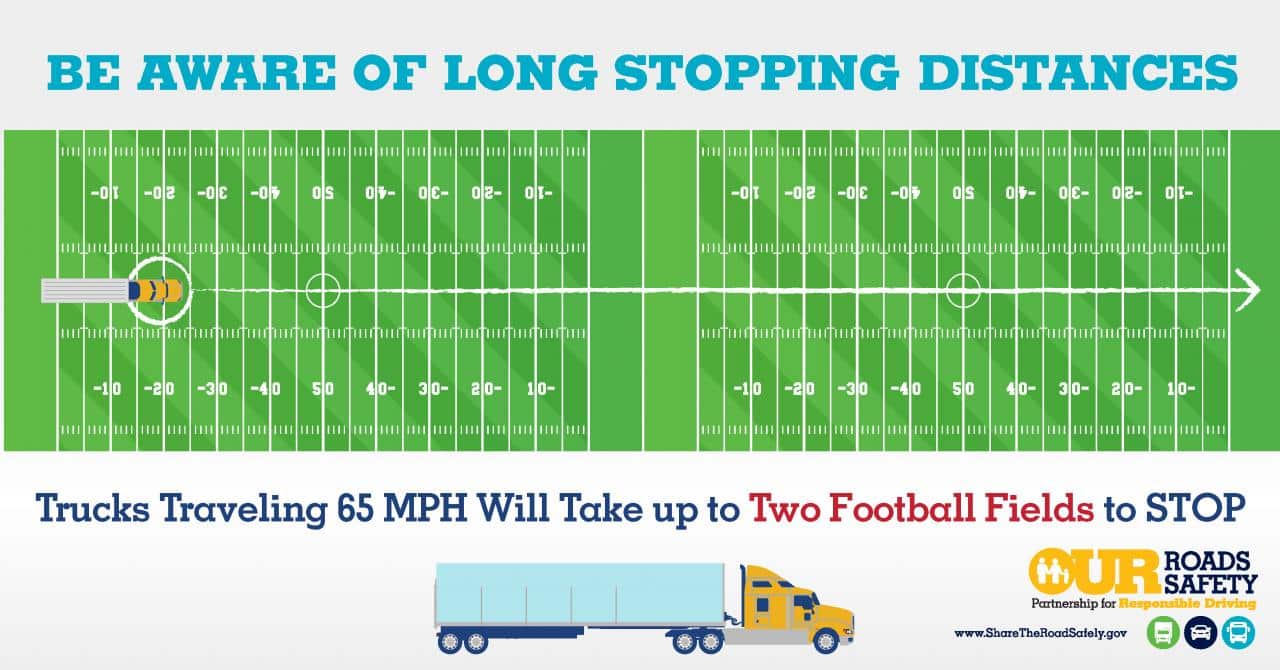
If you have been injured in an 18 wheeler or commercial truck accident in the last 2 years, contact McKay Law at (903) 999-2653 or submit your case for a free consultation. We defend our clients boldly to ensure they receive the best results for their injuries, pain and suffering, lost wages, and medical bills.


























